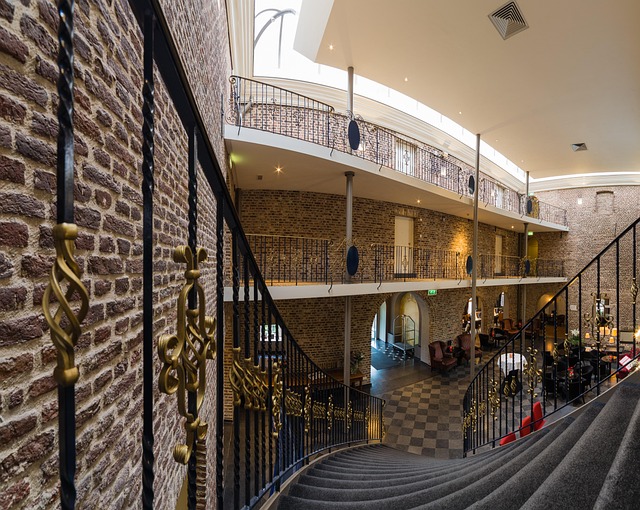Ergonomic modern metal handrails are key for user safety and comfort, with designs reducing strain on arms and hands through shape, diameter, and texture considerations. Durable and versatile, these handrails offer strength, longevity, and aesthetic appeal in residential and commercial spaces. Smooth or textured finishes enhance grip while balancing functionality and style; installation requires precise alignment and suitable hardware to ensure both safety and visual appeal. The ideal choice considers space, safety, and design preferences, making modern metal handrails essential for functional and aesthetically pleasing environments.
Ergonomic handrails are transforming spaces, offering both comfort and safety. Designed with precision, these handrails cater to diverse user needs, ensuring a secure grasp through innovative finishes. This article explores the world of modern metal handrails, delving into material choices, design aesthetics, and grip technologies. From understanding ergonomic fundamentals to selecting the perfect handrail for your space, discover how these elements enhance functionality and user experience in various environments.
Understanding Ergonomic Handrails: Comfort and Safety
Ergonomic handrails are designed with a key focus on comfort and ease of use, making them an essential feature in any modern metal handrail system. These handrails are crafted to reduce strain on the body, particularly the arms and hands, during movement or while supporting weight. By understanding user needs and incorporating ergonomic principles, designers create handrails that provide a secure grip with minimal effort.
The comfort aspect is achieved through careful consideration of the handrail’s shape, diameter, and surface texture. Smooth finishes offer a sleek aesthetic appeal, while textured surfaces enhance grip, preventing slips and falls. This is especially crucial in public spaces where heavy foot traffic ensures constant use, demanding durable and reliable handrails that maintain their functionality over time.
Modern Metal Handrails: Material and Design Considerations
Modern metal handrails are a popular choice for both residential and commercial spaces, offering a blend of strength, durability, and aesthetic appeal. When designing or selecting metal handrails, material quality is paramount. High-grade steel or aluminium alloys ensure longevity against corrosion and wear, crucial factors in high-traffic areas. The smoothness or texture of the finish plays a significant role in grip and comfort; a well-chosen finish enhances usability without compromising on visual appeal.
Design considerations for modern metal handrails focus on ergonomic features. Curved or angled designs provide natural points of contact, reducing strain on the user’s hands and wrists. Incorporating anti-slip textures or diamond-patterned grooves adds another layer of safety, especially in wet conditions. These innovative features not only ensure comfort but also comply with accessibility standards, making them ideal for a wide range of applications, from staircases to platforms and beyond.
Grip Improvement: Smooth vs Textured Finishes
Modern metal handrails, designed with comfort and ease-of-use in mind, offer a variety of finishes to enhance grip. Smooth finishes provide a sleek, contemporary look while offering reduced friction for easy grasping. On the other hand, textured finishes add a tactile element, improving grip by providing better purchase, especially in wet or slippery conditions. The choice between smooth and textured depends on factors like environment, user preferences, and desired aesthetic. For high-traffic areas or spaces with potential moisture, textured handrails offer increased safety and stability. Conversely, sleek, smooth rails align better with modern design aesthetics, suitable for environments prioritizing visual appeal over enhanced grip.
Application and Installation Best Practices
When applying modern metal handrails, proper installation is key to ensuring both functionality and aesthetics. Best practices involve securing handrails firmly to walls or structures using appropriate hardware, like screws or brackets, to withstand weight and prevent slipping. It’s crucial to align handrails precisely for a seamless look and ensure they’re at the correct height for comfortable use.
Textured finishes, such as sandblasted or knurled surfaces, offer enhanced grip, reducing the risk of slips and falls. Smooth finishes, while elegant, require careful consideration of lighting conditions to avoid reflecting light excessively. Proper spacing between handrails is essential—typically 36 to 48 inches apart for adults and lower for children—to provide adequate support and navigation assistance.
Choosing the Right Handrail for Your Space
When selecting a handrail, understanding your space and its intended use is key. Modern metal handrails offer a versatile solution for both residential and commercial settings. For narrow areas, opt for sleek, minimal designs that won’t encroach on precious floor space. More expansive corridors or staircases may benefit from ornate, artistic rails that serve as eye-catching focal points.
Consider the environment as well; high-traffic zones require durable materials like stainless steel with a sturdy, textured finish to prevent slipping and ensure safety. In contrast, more tranquil spaces might suit delicate, smooth-surfaced handrails that complement surrounding décor. Remember, the right handrail not only enhances functionality but also adds aesthetic appeal to any environment.
Ergonomic handrails, especially modern metal handrails, significantly enhance comfort and safety in various spaces. By considering grip improvement through smooth or textured finishes, along with appropriate material and design choices, you can select the ideal handrail for your needs. Adhering to best practices during application and installation ensures longevity and functionality. Whether for residential or commercial use, understanding these factors will help you choose the perfect modern metal handrail to complement any space.
